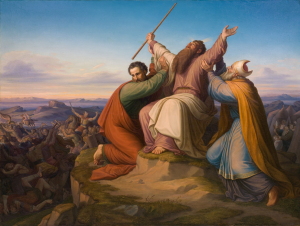This is an archive of Torah and Haftarah readings for Parashat b’Shalaḥ (Exodus 13:17-17:16), the fourth parashah in Sefer Shemot according to the annual Torah reading cycle. The haftarah reading for Parashat b’Shalaḥ is Judges 4:4-5:31. Parashat b’Shalaḥ is preceded by parashat Parashat Bo (Exodus 10:1-13:16). Parashat Yitro (Exodus 18:1-20:22) follows it. Click here to contribute a novel translation of a Torah or Haftarah reading you have prepared for Parashat b’Shalaḥ. Filter resources by Collaborator Name Filter resources by Tag Filter resources by Category Filter resources by Language Filter resources by Date Range
According to Rabbinic tradition, the 21st of Nissan is the day in the Jewish calendar on which Pharaoh’s army was drowned in the Sea of Reeds, and the redeemed children of Yisrael sang the Song of the Sea, the (Shirat Hayam, Exodus 15:1-19). The song, as included in the the morning prayers, comprises one of the most ancient text in Jewish liturgy. The 21st of Nissan corresponds to the 7th day of Passover, and the recitation of the Shirat HaYam is part of the daily Torah Reading. Rabbi Hillel Ḥayim Yisraeli-Lavery shares a performance of a melody he learned for the Shirat Hayam from צוף דבש Tzuf Devash, a Moroccan synagogue in the Old City of Jerusalem. If there is something about this tune that strikes one as particularly celebratory, it might be because the relationship between G!d and the Jewish people is traditionally described as a marriage consummated with the Covenant at Mt. Sinai. The passage of Bnei Yisrael through the Sea of Reeds towards Mt. Sinai thus begins a bridal march commencing in the theophany at Mt. Sinai, 42 days later. . . . Categories: Tags: Contributor(s): The text of parashat B’shalaḥ, distinguished according to the stratigraphic layers of its composition according to the Supplementary Hypothesis. . . . Categories: Tags: 31st century A.M., 8th century B.C.E., annual Torah reading cycle, liberation from mitsrayim, mythopoesis, פרשת השבוע Parashat haShavua, פרשות parashot, קריעת ים סוף qriyat yam suf, redaction criticism, שבת shabbat, פרשת בשלח parashat B'shalaḥ, שירת הים Shirat haYam, Song of the Sea, supplementary hypothesis, ימי השובבים Yemei haShovavim Contributor(s): A Torah reading of Parashat B’shalaḥ in English translation, transtropilated. . . . Categories: Tags: Contributor(s): This piyyuṭ, bearing the acrostic signature “Samuel,” is traditionally recited in the communities of Babylonia and India as a petiḥa, or opening poem, before the Song of the Sea. It is also sung on Shabbat Shira, the Sabbath where we read the Song of the Sea in public. This translation is an attempt to preserve the original meaning as well as the rhyme scheme and poetic form. . . . Categories: Tags: Contributor(s): A medieval manuscript illustration of the aggadah that the Yam Suf was split in 12 discrete channels, one for each tribe, as reflected above by a 12-color rainbow . . . Categories: Tags: Contributor(s): This is a pizmon for Shabbat Shirah (Parashat B’Shalaḥ) by an unknown author. The text is as transcribed from the pizmonim included in the siddur משמרת הקדש: קול שומר שבת Mishmeret haQodesh: Qol Shomer Shabbat (Pisa 1821), p. 117. . . . Categories: Tags: Contributor(s): These are the lyrics of the song, Miryam haNevi’ah, written by rabbis Leila Gal Berner and Arthur Waskow (with Hebrew by Leila Gal Berner) as found published in My People’s Prayer Book, vol. 7: Shabbat at Home, (ed. L. Hoffman, 1997), section 3, p. 189. The English lyrics are from an article published several years earlier — “Memories of a Jewish Lesbian Evening” by Roger McDougle appearing in Bridges (vol. 4:1, Winter/Spring 1994), on the top of page 58. No specific date is given for the havdalah program described in the article, alas. If you know the earliest reference for the publication or use of Miryam haNevi’ah, please contact us. . . . Categories: Tags: Contributor(s): “Shirat Miriam and Devorah / Uri, Uri” (Song of Miriam, Song of Deborah / Rise up, Rise Up) was first published in 2024, as the second of four piyyutim published through the Diwan Ashira Project by Ephraim Kahn. . . . Categories: Tags: 2023-2025 Israel–Hamas war, 21st century C.E., 58th century A.M., Devorah, Miriam, פיוטים piyyuṭim, רשות reshut, פרשת בשלח parashat B'shalaḥ, שבת שירה shabbat shirah, שירת הים Shirat haYam, זמירות zemirot Contributor(s): |



